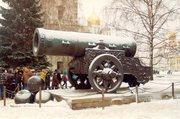Moscow Kremlin
|
|
Moscow_Kremlin.jpg
The Moscow Kremlin (Russian: Московский Кремль) is the best known kremlin (Russian citadel). It is a fortified complex (see Kremlin towers) which includes the Kremlin Palaces and Kremlin Cathedrals, overlooking the Red Square in Moscow. The complex serves as the official residence and principal workplace of the President of the Russian Federation.
| Contents |
History
Moscow_Kremlin_2.jpg
The site originates from the first settlements in the area on Borovitsky Hill where the Neglinnaya River flowed into the Moskva River. From the 11th century there was a significant fortified structure on the hill. The city was greatly extended by Prince Yuri Dolgoruky in the 12th century. The fortress was named the Kremlin in 1331. Between 1366-1368, during the rule of Dmitri Donskoi, a white-stone citadel was constructed. By the 15th century the principalities of Russia were united under Grand Prince Ivan III of Moscow, who became the Grand Prince of All Russia. He organised the reconstruction of the Kremlin, inviting a number of noted builders from Italy, the architect Aristotile Fioravanti among them. Template:Sect-stub
Kremlin_Spasskaya_Tower.jpg
Buildings
The irregular triangle of the Kremlin walls encloses an area of 275,000 square metres (68 acres). Cathedral Square is the heart of the Kremlin. It is surrounded by six buildings, including three cathedrals. The Cathedral of the Dormition is the oldest structure, completed in 1479 to be the main church of Moscow and where all the Tsars were crowned. The massive limestone facade, capped with its five golden cupolas was the design of Fioravanti. The gilded, nine-domed Cathedral of the Annunciation was completed next in 1489. The Cathedral of the Archangel Michael (1508) is on the south-east of the square, where over fifty members of the Russian Royal families are interred. The other notable structure is the Ivan the Great Bell Tower on the north-east corner of the square, it is 81 m (266 ft) high and is said to mark the exact centre of Moscow. Its 21 bells would sound the alarm if any enemy was approaching.

The oldest secular structure still standing is the Palace of Facets (1491), which holds the imperial thrones, it was commissioned by Ivan IV (the Terrible). Next oldest is the first home of the royal family, the Terem Palace. The original Terem Palace was commissioned by Ivan III, but most of the existing palace was built in the 17th century. The Terem Palace and the Palace of Facets are linked by the Grand Kremlin Palace. This was commissioned by Nicholas I in 1838. It was the largest structure in the Kremlin and cost 11 million rubles to build. It contains reception halls, a ceremonial red staircase, and private apartments.
The Northeast corner of the Kremlin is occupied by the Arsenal, which was originally built for Peter the Great in 1701. The current Arsenal was built in 1817 after Napoleon's troops destroyed the previous building in his failed invasion of Russia in 1812.
The northwestern section of the Kremlin holds the Armoury building. Built in 1851, it is currently a museum.
Political figures
The name Kremlin has become a metonym used to refer to the government of the Soviet Union (1922-1991) and its highest members, such as general secretaries, premiers, presidents, ministers, and commissars. To some extent, it is still used in reference to the government of the Russian Federation.
External link
- Moscow Kremlin (http://www.kreml.ru/main_en.asp)
- The Kremlin History (http://xn--e1ajeds9e.ru/eng/articles/history_00.shtml) (http://кремль.ru/eng/articles/history_00.shtml)cs:Kreml
da:Kreml de:Moskauer Kreml fi:Kreml fr:Kremlin de Moscou id:Kremlin ja:クレムリン nl:Kremlin ro:Kremlinul din Moscova ru:Московский Кремль zh:克里姆林宫
